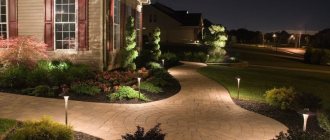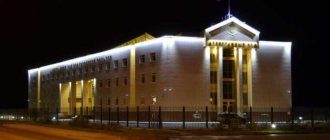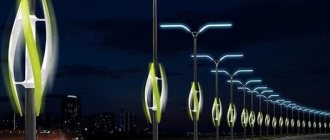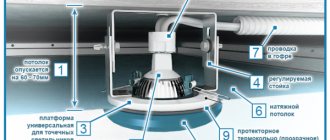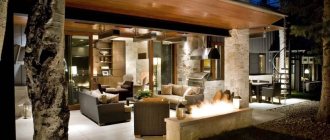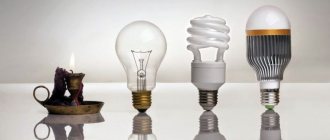Street lighting is part of modern life; it is necessary wherever there is a person - from a city to a small village.
Its main function is to create an artificial luminous flux that meets regulatory requirements and provides the necessary level of safety on roads and pedestrian areas at night.
Utilitarian city street lighting is implemented using lamp posts, supports with cantilever lamps and lighting masts. When planning decorative lighting, various decorative lamps with different levels of illumination, color, shape and installation location are used.
Street light
Street lighting is turned on/off manually, i.e. dispatcher or automatically: circuits with a photocell or solar batteries.
Contents
Story
History of the development of street lighting:
- in 1417, the first street lamps were hung in London at the direction of the mayor;
- at the beginning of the 16th century in Paris, city residents were required to place lamps in windows facing the street, thereby creating artificial lighting;
- In 1668, the first oil street lamp was developed in Amsterdam by fire chief Jan Van der Heijden.
Subsequently, he proposed and implemented a system of street lighting for the city, which involved the installation of 2,500 lamps. This reduced the crime rate in the city, made it easier to respond to fires, and helped citizens avoid falling into canals at night.
Oil lanterns were widely used, despite their dim light, and were used until 1840. Then they were replaced with more modern lamps.
- in 1682 Berlin implemented a street lighting system borrowed from Amsterdam.
- in 1706 in Russia in St. Petersburg under Peter I, the first street lamps were installed on the facades of houses surrounding the Peter and Paul Fortress.
The first street oil lamp
- In 1718, the first stationary street lamps were installed in St. Petersburg.
- In 1723, oil lamps were installed in St. Petersburg to illuminate Nevsky Prospekt.
First lighting of Nevsky Prospekt
- On October 25, 1730, a decree was signed on the implementation of urban lighting in Moscow.
- At the beginning of the 19th century, the Englishman William Murdoch invented the first gas lantern, which had a brighter light compared to oil and kerosene.
- In 1807, gas lamps were installed in almost all European capitals, and in 1839 - in St. Petersburg.
- At the end of the 19th century, the first electric lantern was invented
- In 1879, the first electric lights developed by P.N. were installed on the Liteiny Bridge in St. Petersburg. Yablochkov.
P.N. Yablochkov, Yablochkov’s lantern (candle), the first lighting of the Liteiny Bridge in St. Petersburg (from left to right)
- In 1880, electric lamps with imported high-pressure sodium lamps emitting orange light were installed in Moscow on Okhotny Ryad and Lubyanka.
- In 1883, Yablochkov's lanterns illuminated Nevsky Prospekt in St. Petersburg.
Requirements for street lighting lamps
Street lighting lamps are responsible for road safety, so the following parameters are important when choosing them:
- ease of maintenance and replacement of a burnt-out lamp;
- the degree of protection of the lamp from dust and moisture is at least IP65;
- high resistance to temperature changes and gusts of wind;
- low level of electrical energy consumption while maintaining intense luminous flux;
- durability in operation.
The main parameter characterizing the luminous flux incident from a lighting device onto a surface (road, sidewalk, pedestrian crossing, etc.) is horizontal illumination.
The illumination value is measured with a lux meter. Standard values, calculation methods and parameters of lighting devices are prescribed for each section in GOST R 55706-2013 and SP 52.13330.2016.
For main roads and city streets, the average illumination value ranges from 15 to 20 lux. For regional use it ranges from 10 to 15 lux and for local streets and roads – from 4 to 6 lux. The indicator directly depends on the intensity of traffic, i.e. The more vehicles pass along a section of road in one hour, the higher the average illumination.
Depending on the type of street and road and their purpose, instruction SN 541-82 determines the distance from the support to the lighting object, the distance between the supports, the direction and intensity of the luminous flux.
Types of street lamps
Depending on the installation location and type of fastening, street lamps are divided into:
Ground . They have a sharp leg and are installed in the ground. They are used as an element of landscape design to illuminate paths, flower beds, and facades. To obtain the desired lighting effect, it is advisable to use not one, but several ground lamps installed at a short distance from each other. When choosing, it is important to pay special attention to the resistance of the material from which the lanterns are made to adverse weather conditions, ultraviolet radiation and physical damage.
Ground lamps
Embedded . Designed for lighting garden paths, swimming pools and fountains, they have a waterproof housing.
Recessed luminaires
Hanging . These are decorative lamps for the garden, equipped with a long pendant for mounting to the ceiling. They will look beautiful on the veranda, terrace, or gazebo.
Hanging lantern
Facade. Used to illuminate the facade of a house and other buildings. Mounted on the wall, can be rotary or stationary.
House façade lighting
Wall mounted . Wall lanterns look beautiful at the front door, on the walls of a gazebo or veranda. Depending on the design of the site, you can choose lamps in an antique or modern style.
Wall lanterns
Ground lights. As a rule, they have a base in the form of a pillar of varying lengths. Street ground lights are designed to illuminate a large area, so their power is higher than that of other types of lamps. When choosing them, you need to focus on the stability and durability of the material, as well as energy efficiency.
Ground lantern in the garden
Park ground lamp "Ball"
Console lamps. They can have different appearance and shape, they are united by their fastening device. Using a cantilever element, such lamps are mounted on posts or supports, which are purchased separately or made independently, for example, from wood. They can be installed along a fence or path.
Console lamp
Classification of outdoor lighting
Types of lighting devices, their power, design, installation rules and much more depend on the object of illumination. Types of street lighting:
Dvorovoye
Yard lighting is designed to create an artificial light flow in the adjacent home area, driveways, playgrounds, etc. Creating lighting increases the level of safety at night.
For yard lighting, lamp posts, wall lanterns, spotlights, and, more rarely, elements of designer lighting and lighting are used. Street lamps are equipped with an anti-vandal system and a high degree of protection.
To illuminate the entrance to the house's entrance, wall lamps of the reinforced concrete type are used. It has a warm white light that does not irritate the human eye, and creates good visibility in poor visibility conditions (snowfall, fog, rain).
Yard lighting
Road
Road lighting is clearly defined by the rules and must ensure the level of safety for road users (drivers, pedestrians).
In areas with high traffic intensity (highways, city roads), lamps with a reflector are used. This helps to “collect” the light flux without scattering it. Thus, by installing the lamp at a high height, a large section of the road is illuminated, and the distance between the supports increases.
For roads with less intensity, lamps with reflective and diffuse lighting are used.
Today, when installing street road lighting, LED lamps are used, because... they have a stable luminous flux, brightness, are durable and energy-intensive.
Road lighting
Pedestrian crossings, sidewalks
Lamps with diffuse lighting are used to illuminate pedestrian crossings, sidewalks, bicycle paths, and playgrounds. This allows light to be scattered over a long distance.
To illuminate a pedestrian crossing, LED spotlights are used with a directed luminous flux across the axis of the roadway, thereby allowing the driver to see the pedestrian at a long distance.
Sidewalk lighting
Pedestrian crossing lighting
Decorative
Decorative lighting does not carry the functions of utilitarian lighting; rather, it is intended to emphasize the features of an architectural structure, landscape design or gardening areas.
To implement it, LED strips, spot “floor” lamps, lanterns on low legs, and in some cases multi-colored lamps are used.
Decorative lighting
Recommendations for selection
When choosing street lamps, the following criteria are taken into account:
- Degree of protection against dust and moisture
The higher the IP value, the higher the protection of lighting equipment. If the devices are located outdoors, they must be reliably protected from water and dust. In this case, it is necessary to choose a street lamp with a protection class from IP 44 to IP 68. The first number indicates the degree of protection against dust, and the second - protection against water. For electrical appliances that are installed under a canopy, a protection level from IP 20 to IP 43 is acceptable.
- Material
Lamps with steel supports will last a long time and will not require frequent maintenance.
Classic and modern models are popular. Metal lanterns are durable and attractive in appearance. Aluminum alloy is also used in the production of supports. The material is light and not afraid of corrosion.
Anti-vandal structures are made of cast iron. Cast iron supports are resistant to mechanical and wind loads.
- Type of lamps
To save energy, LED lamps are installed. They consume 7-8 times less electricity and can operate continuously for 5 years. During operation, the LEDs do not heat up, which protects the glass or polymer shade from cracks due to temperature differences.
- Additional options
To make decorative lighting in the garden practical and economical, the lanterns are additionally equipped with motion sensors.
The sensor is triggered automatically when you approach the lighting fixture. For landscape lighting, solar panels are also installed that power LED lamps.
Types of light sources
Incandescent
The well-known incandescent lamp structurally consists of a base, an incandescent filament and a bulb filled with an inert gas. When electrical energy is applied, the filament heats up, thereby creating a glow.
Such lamps are rarely used for outdoor lighting, as they have high heat loss, and accordingly, large amounts of power are required to create the required luminous flux.
Incandescent lamp
Gas discharge lamps
A mercury arc fluorescent lamp (MAFL) consists of a base, a quartz burner, and a glass bulb. The latter is coated on the inside with ultraviolet light and filled with an inert gas (nitrogen). A quartz burner is filled with argon with mercury particles; it is in it that, when electrical energy is supplied, a discharge occurs, followed by arcing. The glow from the arc is converted by ultraviolet light into the light spectrum.
To start, stabilize the operating current and protect against burnout, gas-discharge lamps are equipped with ballasts (ballasts). In the case of DRL lamps, it is represented by a choke, which is connected in series to the supply network.
DRL lamp
Such lamps have a bright luminous flux and high power, which leads to heating of its structure and associated parts.
They are used to illuminate roads, highways, streets, parks, and pedestrian crossings.
In order to maintain environmental safety, today manufacturers are moving away from using mercury lamps.
Sodium arc tube lamp (HSA) is a high-pressure gas-discharge lamp. Its design and method of connection to the electrical network are similar to gas-discharge lamps. The only exception is that the gas discharge occurs in sodium vapor, and not mercury, as in DRL lamps.
Ballasts for HPS lamps are presented in the form of a series-connected choke and a pulse ignition device (IZD). The latter generates and supplies a high-frequency voltage pulse to the lamp, with the help of which the arc is ignited and the lamp burns.
HPS lamp
Due to their high power and yellow-orange light, they are used directly for street lighting. It is not recommended to use such lamps for household purposes.
Compact fluorescent lamps (CFLs) are similar in design and operating principle to gas-discharge lamps. Its difference is in the curved tubular design of the flask and built-in ballast, which is represented by a choke.
Fluorescent lamps are known for their low electrical energy consumption. They have high luminous efficiency and stable luminous flux. They are used for lighting parks, local areas, façade or decorative lighting.
CFL lamp
Metal halide lamps (MHLs) are similar in design and operating principle to high-pressure discharge lamps. The difference is the presence of special radiating additives (sodium iodide) in mercury vapor.
The performance of the lamp is independent of the environment. They have a stable luminous flux, good light output and color rendition.
The disadvantages include the service life, which is limited by the number of times the lamp is turned on/off.
It is used for lighting highways, stadiums, and large open areas.
MGL lamp
LED
Despite the popularity that LED road lighting has gained, today the process of their degradation is becoming more frequent. LED degradation means a change in its operating and technical characteristics: a decrease in luminous flux, breakdown of semiconductors.
One of the common causes of degradation is poor-quality assembly of the lamp and the use of low-quality components.
When using a bad driver, which is responsible for the degree of heating of the diode and heat removal, the diode overheats and, as a result, fails (breakdown).
Often, in order to reduce the cost of an LED lamp, manufacturers install diodes close to each other, which also leads to their overheating.
It is important to give preference to trusted brands that follow assembly rules and do not skimp on components.
Xenon
A xenon lamp structurally consists of a vacuum flask made of quartz glass and filled with xenon. Inside the flask there are two tungsten electrodes with thorium impurities. This design allows you to withstand high pressure inside the bulb when the arc burns, which creates a luminous flux.
Xenon lamps have high power and a stable luminous flux of bright white light. They are economical in electrical energy consumption and have a long service life.
The disadvantage of such a lamp is the presence of high pressure, which can lead to its explosion.
It is used for street lighting of roads, pedestrian areas and crossings, and park areas.
Xenon lamp
Induction
An induction lamp consists of a gas-discharge bulb filled with ionized gas. The inner layer of the bulb is covered with a reflective coating (phosphor or silicon). An electronic generator is located inside, which supplies high-frequency current to the primary coil; the role of the secondary coil is played by the cavity of the bulb.
High-frequency electric current is supplied through a generator to the primary coil of the lamp. Secondary coil - ionized gas is short-circuited. A high-frequency magnetic flux arises in the flask, which at a certain moment leads to breakdown of the gas and its ionization begins. The lamp glows.
The lamps have high color rendering, luminous flux and brightness, long service life, and an unlimited number of on/off switches. The disadvantages include the need for special disposal due to the mercury content.
It is used in places where high light output is required: roads, tunnels, pedestrian crossings, parking lots, open warehouses, stadiums.
Lamps with induction lamp
Types of lamps
Modern urban lighting is implemented using lamps and lanterns, which are divided into the following types:
- floor lamps One or more lighting devices are installed on a support with a height of 70 cm to 500 cm. The light is distributed evenly from top to bottom. They are used for street lighting of pedestrian, park, garden areas, children's playgrounds, and squares.
Floor lamp
- Facade. The lamp is attached with a bracket to the facade of the house. They are used for illuminating entrance areas, illuminating information signs and signboards.
Facade lantern
- Landscape. They have different versions, because... used for decorative lighting of landscape elements in parks and squares.
Landscape lantern
- Trunk. The luminaires are installed on high poles along highways and roads. They have a powerful luminous flux directed from top to bottom onto the roadway.
Main lantern
The types of modern street floodlights depend on:
- lamps used (MGL, LED, sodium, etc.);
- light distribution (one-two-plane);
Depending on the power, floodlights are used to illuminate various areas from the entrance to large stadiums.
Smart lighting
Constantly turning street lights on and off manually is not for the faint of heart. Yes, a single light bulb above the porch can be turned on and off personally, but what to do if an entire lighting system with a dozen or more lamps is built on the site? It is necessary to somehow automate the process of turning on/off the lighting, and the following devices will help to do this:
- The photo relay allows you to detect the onset of twilight and turn on the lighting. With the onset of dawn, the light bulbs will go out on their own. The relay itself is installed in the electrical panel, and the sensor is installed in any convenient place on the site;
- The astronomical relay is based not on information about the level of illumination, but on data on the geographic coordinates of the area, which are entered manually. The microprocessor calculates the time of sunset and sunrise on a certain day of the year and gives commands to turn the lights on or off;
- a temporary relay requires you to turn on the lights manually (this can be one lever for all the light bulbs), but they will turn off on their own after a predetermined period of time;
- The motion sensor will command to turn on only after movement is detected within a certain radius. Works well together with a photo relay. Depending on the model, the motion sensor can be configured in different ways, setting the response radius, the time of day at which it will be active, etc.
We also note solar-powered lamps , which do not consume electricity, but can also be equipped with light sensors to turn on independently as dusk falls.
The article was written for the site.
Tags:Lighting systems
Solar road lights
More and more often you can find lamps on the roads that operate from an autonomous energy source - solar panels. In particular, on the streets of small settlements, on pedestrian and bicycle paths and pedestrian crossings. In the latter, the design is often equipped with a motion sensor.
An LED solar lamp consists of an LED panel, a battery and a controller, which is responsible for charging and distributing energy. During the day, the device accumulates energy, which is used to maintain the level of illumination after dark.
pros
- lack of connection to the electrical network;
- small dimensions and weight;
- ease of installation;
- zero electrical energy consumption;
- compliance with environmental safety standards.
Minuses
- the presence of a constant source of energy - sunlight;
- inability to carry out repair work;
- limited operating time of the lamp;
- fading of light flux over time.
Lighting a pedestrian crossing using a solar battery
Types of supports
| Type of supports | |||
| Metal | |||
| Material | |||
| Steel, cast iron, aluminum, galvanized | |||
| Advantages | Flaws | ||
| Compactness | Corrodes | ||
| Light weight | The need for periodic painting | ||
| Design variability (easy to increase or decrease) | High price | ||
| Simplicity of installation and dismantling work | |||
| Service life up to 80 years | |||
| Beautiful design | |||
| Type of supports | |||
| Wooden | |||
| Material | |||
| Tree | |||
| Advantages | Flaws | ||
| Light weight | Selection of identical logs | ||
| Simplicity of installation and dismantling work | Not resistant to severe frosts, in particular to ice | ||
| Low cost | Periodic implementation of measures for treatment with protective agents (impregnation) | ||
| High resistance to loads (impacts, bends) | Wood rotting (in the absence of impregnation) | ||
| Dielectric properties | |||
| Long service life (if impregnated) | |||
| Resistance to high humidity (if impregnated) | |||
| Type of supports | |||
| Concrete | |||
| Material | |||
| Concrete | |||
| Advantages | Flaws | ||
| Low cost | Are subject to destruction at high humidity | ||
| Service life up to 50 years | Not attractive design | ||
| Easy to carry out periodic maintenance | |||
| Type of supports | |||
| Reinforced concrete | |||
| Material | |||
| Metal, concrete | |||
| Advantages | Flaws | ||
| Resistant to heavy loads | Not resistant to shock loads | ||
| Affordable price | Not attractive design | ||
| Resistance to temperature changes | |||
| Corrosion resistance | |||
| Durability | |||
TYPES AND TYPES OF LAMPS FOR STREET LIGHTS
Until relatively recently, street lamps used incandescent lamps, which, while possessing the necessary brightness and power characteristics, were characterized by low reliability and high energy consumption.
The use of halogen light sources, in which halogen pairs were used as bulb filler, made it possible to slightly increase economic indicators. Their service life is approximately 2 times longer than that of conventional incandescent lamps. Currently, these types of lamps are practically not used.
They were replaced by more economical gas-discharge light sources. These include lamps in the bulb of which there are vapors:
- mercury (DRL);
- sodium (DNAT).
Here, mercury or sodium vapors are responsible for creating the light flux. Such light sources are characterized by high power and are capable of providing effective illumination of outdoor space over large areas. DRL lamps emit a white luminous flux, and HPT lamps produce a yellow luminous flux.
However, they have a number of disadvantages, the main one of which is their susceptibility to temperature changes, which is associated with the strong heating of the glass bulb. Therefore, the bulbs of gas-discharge lamps are made of special heat-resistant glass.
Now mercury and sodium lamps are gradually being replaced by metal halide lamps (MHL), which use mercury vapor with some addition of halide components (sodium, thallium and indium iodides and bromides) to create a luminous flux.
The power of such lamps reaches about 2 kW, which allows them to be used for lighting large areas and sports facilities.
The following types of lamps are also widely used in street lamps:
Luminescent
, the service life of which significantly exceeds that of incandescent lamps. In them, ultraviolet radiation arising after a gas discharge is converted into a luminous flux of the visible spectrum using a phosphor coating applied to the inner walls of the glass bulb.
They have low energy consumption, but are not safe to use. This is due to the fact that the luminous flux of the lamp is determined by mercury located in its bulb and which, if the latter is damaged, can enter the environment.
Xenon
, in which the luminous flux is created by an electric arc burning between two tungsten electrodes located in an inert gas environment with the addition of mercury and sodium salts.
Induction
, operating due to the glow of plasma resulting from the ionization of gas by a magnetic field formed by inductance coils. In this case, the latter are placed near the gas cartridge.
Negative properties of street lighting
The main task of a street lighting design engineer on a highway and highway is to select lighting devices in such a way that they:
- did not blind drivers and pedestrians.
- corresponded to low electrical energy consumption.
- met environmental safety requirements.
As a result of light entering the eyes, the driver loses attention, which negatively affects safety. To prevent such cases, it is necessary to install lamps without a scattering effect, the light flux is directed strictly downwards, without deviations to the sides.
For acceptable electrical energy consumption and minimization of light pollution, i.e. lighting objects that do not require this is necessary:
- lamps of the required power are selected;
- the required number of lamps, the height of their suspension and the direction of the light flux are calculated;
- the design of the lamp is chosen correctly.
- the luminous intensity curve (LIC) characterizes the angle of distribution of the luminous flux. For street (main) lighting, semi-wide L (140o) and wide M (160o) KSS are used. This allows you to evenly illuminate the area along its entire length, without creating blinding zones.
Semi-wide and wide type KSS scheme
Examples and ideas for road and street lighting
Modern street lights add a touch of architectural design to street and road lighting without compromising safety or code compliance.
- Related Posts
- Phosphor: composition, purpose and application
- Track lighting system: device, types and ideas
- How to properly use emergency lighting with all current standards and requirements
What features are hidden by street lighting lamps?
What is the main difference between lighting fixtures at home and outdoors - in operating conditions. The structure must perform a lighting function at night and withstand the influence of dust, moisture, temperature changes and mechanical stress 24 hours every day. At the same time, lanterns are often required to fulfill design ideas.
The main criteria in selecting lighting for the street are:
- Sturdy sealed housing;
- Safety index IP44 and higher;
- Energy efficiency;
- High working resource;
- Design;
- Mobility and compactness;
- Ease of installation.
As a material, it is desirable to use metal or ceramics. Ceramics, of course, is a rather fragile material, but its fire safety deserves attention. The type of lamps used is another feature. Halogen lamps have gained great popularity here. They are almost never used in the home due to the property of such lamps to heat up quickly and strongly, but their unpretentiousness to external conditions, high color rendering and attractive price have made them indispensable in street lighting.
LED lamps are the second most popular. They are safe, economical, do not require warm-up time and expand the range of solar-powered lamps.
Spotlights cost approximately the same in both cases, but light bulbs have different starting prices. LEDs are more expensive. Another distinctive feature is the feasibility of using solar energy, which greatly simplifies installation and increases efficiency. Lanterns using such batteries can be either large for lighting paths or small for decorative purposes.
